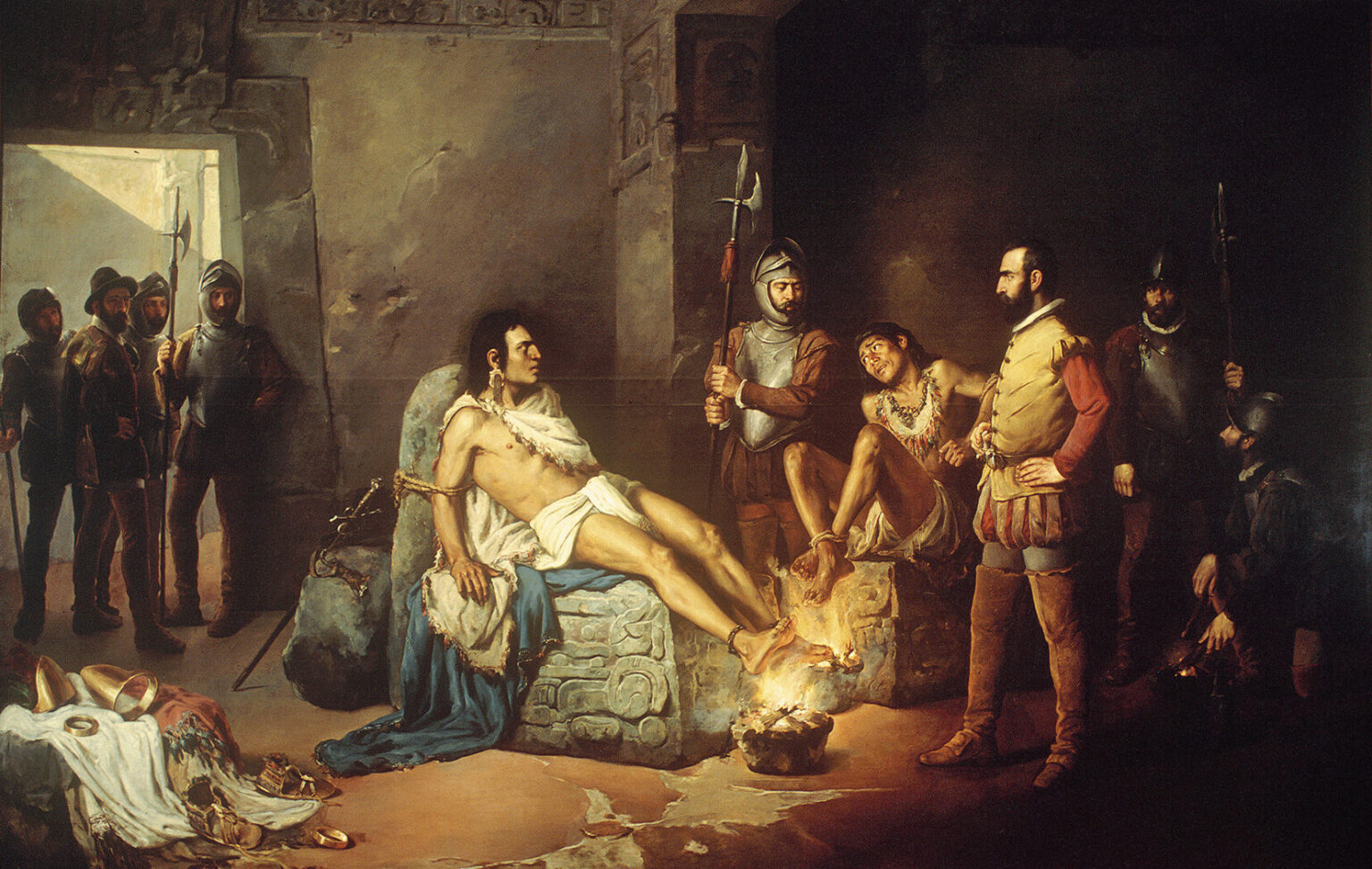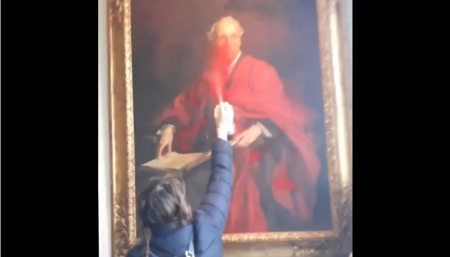In northern Mexico City, about three miles west of the Palace of San Lazaro, stands a tall monument topped with a bronze statue of Cuauhtemoc, the last Huey Tlatoani, or emperor, of Mexico-Tenochtitlan. On the base of the monument, which was erected almost four centuries after Cuauhtemoc’s defeat at the hands of the Spanish conquistadors, is the following inscription:
A la memoria de Quautemoc y de los guerreros que combatieron heroicamente en defensa de su patria.
Or, in English:
To the memory of Cuauhtemoc and the warriors who battled heroically in defense of their fatherland.
Cuauhtemoc was born into a royal house that ruled over about six million people, from a capital whose size and wealth rivaled the best cities of Western Europe. All of this changed in November of 1519, when the emperor made the ill-advised decision to let Hernan Cortes, who had arrived with a force of about 600 Spaniards and 20,000 Tlaxcaltecs, into the capital for negotiations. In a failed bid to preserve his own life, Montezuma ended up governing as Cortes’s puppet for several months while the Spaniards ransacked the city for gold, until at last they were expelled in an uprising led by the fallen emperor’s brother, Cuitlahuac.
Cuitlahuac died of smallpox after only 80 days on the throne, and the chiefs of the Mexica proclaimed his 25-year-old cousin, Cuauhtemoc, the new Huey Tlatoani. Meanwhile, Cortes had retreated to his base in Tlaxcala, a hardy indigenous republic that had decided to support the Spaniards’ bid to take the place of the Mexica as overlords of what would later be called New Spain.
Within a year, Cortes was back in the Valley of Mexico with an even larger army. All of Cuauhtemoc’s former advantages were gone. Most of his vassals, upon seeing that a new power had arrived in their world, had leapt at the chance to rebel against him, and there were now as many natives attacking Mexico-Tenochtitlan as defending it. Meanwhile the capital, which stood in the middle of a lake and could only be reached by long causeways, was not quite as isolated as before, thanks to a Spanish shipwright named Martin Lopez, who had taught the Tlaxcaltec carpenters how to build lake brigantines, which they carried over the mountains in pieces and reassembled on the shores of Lake Texcoco.
Notwithstanding all these advantages, plus such wonder weapons as steel swords, steel breastplates, horses, and cannon, the siege of Tenochtitlan was no easy battle for Cortes’s men, and the Mexica held out for 79 days. Early on they even won a small victory, when two brigantines chased a fleet of canoes into a reedy thicket, ran aground on submerged palisades, and were taken in an ambush. When the Spaniards had reached the main island, they were often lured into narrow alleyways, or backed against canals, where their weapons and tactics availed them little. More than a hundred Spaniards were taken alive in these skirmishes and sacrificed to the gods; their heads and hands were sent to the Spaniards’ native allies to intimidate them into deserting. It was only with great effort that Cortes kept his army together.
The battle did not end until about half of Tenochtitlan’s inhabitants were dead, and seven-eighths of the city had been razed to the ground. On August 13, 1521, Cuauhtemoc surrendered, fully expecting to be ritually killed in much the same way as his own empire’s defeated foes. Instead, Cortes spared his life—for the next four years. In 1525 he was implicated, along with several other Aztec nobles, in a conspiracy to assassinate Cortes, and the men were hanged from a ceiba tree.
William H. Prescott, the grandson of the hero of Bunker Hill, whose 1843 History of the Conquest of Mexico was largely responsible for introducing these events to the English-speaking world, had this to say of Guatemozin (i.e., Cuauhtemoc):
Such was the sad end of Guatemozin, the last emperor of the Aztecs, if we might not rather call him “the last of the Aztecs,” since, from this time, broken in spirit and without a head, the remnant of the nation resigned itself, almost without a struggle, to the stern yoke of its oppressors. Among all the names of barbarian princes, there are few entitled to a higher place on the roll of fame than that of Guatemozin. He was young, and his public career was not long; but it was glorious. He was called to the throne in the convulsed and expiring hours of the monarchy, when the banded nations of Anahuac and the fierce European were thundering at the gates of the capital. It was a post of tremendous responsibility; but Guatemozin’s conduct fully justified the choice of him to fill it. No one can refuse his admiration to the intrepid spirit which could prolong a defence of his city, while one stone was left upon another; and our sympathies, for the time, are inevitably thrown more into the scale of the rude chieftain, thus battling for his country’s freedom, than into that of his civilized and successful antagonist.
Are these the words of an airy idealist, filled with romantic fantasies of the noble savage? A man so eager to make out the Europeans as villains that he was willing to overlook the brutality of Cuauhtemoc’s empire, and the 20,000 or so human sacrifices it performed each year? Hardly. In another passage, Prescott writes:
The Indian empire was in a manner conquered by Indians…. The Aztec monarchy fell by the hands of its own subjects, under the direction of European sagacity and science. Had it bean united, it might have bidden defiance to the invaders. As it was, the capital was dissevered from the rest of the country, and the bolt, which might have passed off comparatively harmless, had the empire been cemented by a common principle of loyalty and patriotism, now found its way into every crack and crevice of the ill-compacted fabric, and buried it in its own ruins. Its fate may serve as a striking proof, that a government, which does not rest on the sympathies of its subjects, cannot long abide; that human institutions, when not connected with human prosperity and progress, must fall – if not before the increasing light of civilization, by the hand of violence; by violence from within, if not from without. And who shall lament their fall?
Basically, William H. Prescott had a clear enough view of history to see that men worthy of admiration can be found on all sides of a conflict. And while he could hardly regret the final outcome of the war, he could, at the same time, admire the courage and skill that Cuauhtemoc and the other Mexican warriors showed in defense of their homeland, and of the only way of life they had ever known.
Nobody in present-day Mexico is trying to bring back the Aztec system of government, or the religious rites that flourished beneath it. At the same time, nobody is trying to tear down Cuauhtemoc’s statues, or scrub his name off of streets and plazas. Most Mexicans seem to recognize the injustice of erasing a man from history because he didn’t live up to a later culture’s moral principles.
At least, they recognize the injustice of doing that to a non-white man. Europeans such as Cortes himself are different. There are hardly any statues of Cortes left in Mexico, and those that remain are frequent targets of vandalism. This, in a country where everyone alive today, of whatever political persuasion, has a lot more in common with the Spanish viceroys than with the regime that they replaced.
Meanwhile, one country to the north, it is Confederate heroes who have borne the brunt of the double-standard. All of the virtues that Prescott praised in Cuauhtemoc are also to be found in Robert E. Lee, Stonewall Jackson, James Longstreet, and Nathan Bedford Forrest. Like the Mexica during Cortes’s final siege, they showed great courage and resourcefulness in defending a homeland that—however barbaric its way of life might look to future generations—commanded in them the most natural feelings of patriotic duty. They faced a more numerous, technologically superior enemy, and they held out much longer than might have been expected.
“Honour thy father and thy mother, that thy days may be long upon the land, which the LORD thy God giveth thee.”
To Christians and Jews, this is one of the Ten Commandments revealed from heaven at Sinai. But it is also ingrained so deeply in mankind’s sense of natural law that one would search in vain for a pagan nation for whom filial piety is not a central virtue. Most of the human beings who ever lived have never seriously doubted the moral lessons that they received, by word and by example, from their parents and older generations.
If you accept the worldview of enlightenment liberalism—or, for that matter, the worldviews of medieval Christendom and biblical Israel that lie at its root—then you will recognize limits to this virtue. Gideon destroyed his father’s altar to Baal; King Asa burned his mother’s idol of Asherah; both are praised by the Biblical narrator for these deeds. Yet Gideon only destroyed the Baal altar after an angel told him to do it, and Asa probably had temple priests to turn him against the cult of Asherah. Left wholly to themselves, neither of these men would have acted; our culture puts hard limits on what even the best of us can do.
Robert E. Lee grew up in the American South, at a time when slavery had been an ordinary part of life since long before the birth of anyone then living. Yet slavery existed uneasily in a nation that justified its own founding with a claim that “all men are created equal.” Meanwhile, that pro- and anti-slavery ministers could peach from the same Bible only added to the confusion.
Over the first 55 years of his life, Lee entertained many doubts about the morality of slavery, and he even manumitted several of his own slaves in 1862. Lee also viewed the secession of the southern states as a dangerous mistake. Yet when the matter came to war, he never doubted which side he would have to fight on: Virginia was his homeland, and defending Virginia from invasion was his duty, and the pricklier points of the slave question didn’t change any of that.
Nathan Bedford Forrest is a harder man to honor than Lee; his brutality toward black Union soldiers during the war, and his role in founding the Ku Klux Klan after it was over, do not reflect well on his character. But like Lee, Jackson, and Longstreet, as a soldier Forrest was ultimately a man fighting to defend his homeland, and the only way of life he had ever known, from violent disruption by outsiders.
When the war broke out in 1861, the 39-year-old Bedford Forrest left behind his prosperous life as a plantation owner and livestock trader to enlist as a private in the Confederate Army (he was the only soldier on either side of the war to be promoted from private all the way to lieutenant general). This sort of courage and dutifulness is nothing to wink at, even in a man whose values are offensive to our own.
If leftists continue to shine the best possible light on Aztec war heroes who literally cut people’s hearts out and offered them to their gods, then they have no real basis for wailing on Forrest. Cuauhtemoc, of course, grew up in a world where opposition to human sacrifice didn’t exist at all. In his country, courage in battle, honest conduct within one’s own social class, and fierce loyalty to one’s tribe were the only virtues—and they were virtues that he displayed par excellence during his short and chaotic life.
To the fair-minded observer, Robert E. Lee, Nathan Bedford Forrest, and Cuauhtemoc have much in common with each other—and with many heroes who are generally seen on the “right” side of history, such as Abraham Lincoln, Winston Churchill, or Volodymyr Zelensky. It is of course rare for leftists to see things this way. They seldom ask about a man’s character, the complex amalgamation of virtues and vices that drive his conduct. Instead, they ask mainly about his race and his social background. Cuauhtemoc and his countrymen were people of color; thus they can only be victims, not oppressors. General Lee? He was a brutal racist.
Defend Lee’s statues, this sort of thinking seems to suggest, and a moment later you’ll be trying to put up statues of Hitler and Himmler. But it is very easy for a thoughtful person to make a distinction here. Hitler and Himmler didn’t grow up in a world where it was acceptable to gas the Jews. The Nazis, and the Communists, fought to introduce new evils to society, not to defend a cultural heritage to which they were bound, despite its flaws, by ancestral custom and natural law. An enormous gulf lies between the Nazis’ death camps and Cuauhtemoc’s human sacrifice, and an even larger one between Nazis and the Confederate generals.
Yet the political left has a way of looking at violence and oppression that effaces all these distinctions. It goes somewhat like this: white on white violence is bad, white on non-white violence is worse, non-white on white violence is unthinkable, and non-white on non-white violence is ignored.
The rule is simple, but it explains a lot of things. Why do anti-gun activists care more about mass shootings (which are mostly white-on-white) than the much deadlier problem of urban gang violence? Because nonwhite-on-nonwhite violence is ignored. Why did the 2015 Charleston church massacre stay at the top of the news for so much longer than did most other mass shootings? Because its perpetrator was white, and its victims were black. Why did the 2016 sniper attack that killed five policemen, and wounded nine others, at a Dallas BLM rally get dropped by the press like a hot rock? Because it was the other way around.
This rule even works at the largest scales of geopolitics. During the Cold War, the United States allied with Red China against the USSR because the nonwhite-on-nonwhite violence of the former was more palatable, to America’s liberal elites, than the white-on-white violence of the latter. Yet the USSR, despised as it was, never had to face anywhere near the hatred from American liberals that the pre-1994 regime in South Africa endured. After all, even though white-on-white violence is bad, white-on-nonwhite violence is worse. And since nonwhite-on-white violence is unthinkable, when people in present-day South Africa sing about killing white farmers, the New York Times writes an op-ed about how the song isn’t hateful.
This same principle explains why minimizing the Holocaust (white-on-white violence) will ruin your career, while minimizing Aztec human sacrifice (nonwhite-on-nonwhite, except for a few Spaniards at the very end) usually won’t. It also explains why it’s so much easier to have a statue of Cuauhtemoc than one of Robert E. Lee. After all, those hundreds of towns and villages that had to send tribute of boys and girls for slavery and sacrifice to Mexico-Tenochtitlan were of course nonwhite, but so were their rulers. So all is forgiven.
Don’t you know your Kendithought? Aren’t you aware that oppression requires whiteness? Hernan Cortes and his companions? Robert E. Lee, Stonewall Jackson, James Longstreet, and Nathan Bedford Forrest? Those men were evil incarnate. People with a healthy respect for our collective human past—or even just an ounce or two of common sense—will recognize this double standard for the absurdity it is.
The statues of Cuauhtemoc should keep standing, and the statues of Robert E. Lee should also keep standing, and for the same reasons. If we are to learn from the past, and not use it as a mere political football, then we need to preserve the memory of great men in their full human complexity—both admiring their greatness and recognizing their flaws.
We also need to acknowledge that all of us, whatever our race, are subject to the same human failings and weaknesses. Had we lived in the past, we would most assuredly have believed things, and done things, that we find dreadful in the present. And as we live in the present, we will believe things, and do things, that people will find dreadful in the future. If we want future generations to acknowledge our strengths, and not just condemn our weaknesses—to refrain from bulldozing our statues—then we had better learn to extend the same courtesy to the generations that came before us.
Read the full article here














